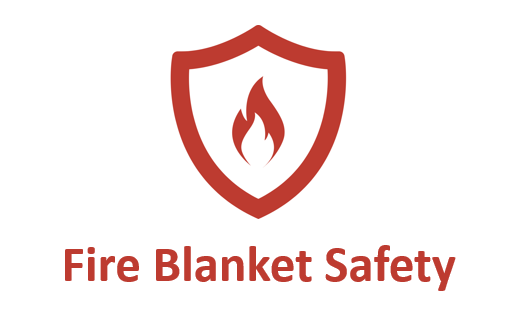
From the moment we wake up to the time we turn in for the night, we're surrounded by potential fire hazards – whether it's the flickering flame of a candle, the sizzle of a hot pan on the stove, or the electrical appliances humming in the background.
In the face of these potential risks, having a solid understanding of fire safety protocols and tools is not just practical – it's essential. And that's where the fire blanket shines as a beacon of safety and reassurance.
Are you ready to unravel the mysteries of this indispensable fire safety tool? Let's ignite our curiosity and delve into the fascinating land of fire blankets.
Crafting Fire Safety: Understanding the Composition and Design of Fire Blankets
Fire blankets are engineered with specific materials and designs to effectively smother flames and shield against heat during fire emergencies. Understanding their composition and design is crucial for appreciating their effectiveness in fire safety measures.
Fire blankets are typically made from flame-resistant materials that can withstand high temperatures without catching fire themselves. The most common materials used in fire blanket construction include:
Fiberglass fire blankets are woven from glass fibers treated with flame-retardant chemicals. This material is highly heat-resistant and provides excellent protection against flames, making it a popular choice for fire blankets.
Fire blankets made from specially treated wool are also widely used. Wool fibers are naturally flame-resistant and can withstand high temperatures. When treated with fire-retardant chemicals, wool blankets become even more effective at extinguishing fires.
In addition to fiberglass and wool, fire blankets may also incorporate synthetic materials such as aramid fibers e.g., Nomex or Kevlar or silicone-coated fabrics. These materials offer enhanced durability and heat resistance, further bolstering the fire blanket's effectiveness.
Fire blankets come in various sizes and shapes to accommodate different applications and environments. Common sizes range from compact sheets suitable for household use to large fire blankets designed for industrial settings. The shape of a fire blanket can vary as well, with rectangular, square, or circular options available.
The size and shape of a fire blanket are carefully designed to ensure adequate coverage and ease of deployment during fire emergencies. Smaller blankets are convenient for covering small fires or wrapping around a person to extinguish flames on clothing, while larger blankets are suitable for smothering larger fires or shielding against radiant heat.
Functionality of Fire Blankets
Fire blankets serve a critical role in fire safety by providing a versatile and effective means of extinguishing small fires and shielding against heat and flames. Understanding their functionality is essential for appreciating their effectiveness in fire emergency situations.
1. Smothering Flames
One of the primary functions of a fire blanket is to smother flames by cutting off the fire's oxygen supply. When deployed over a small fire, the blanket forms a barrier that prevents oxygen from reaching the flames, thereby extinguishing them. This suffocation effect is particularly effective for fires fueled by combustible materials such as wood, paper, or fabric.
2. Shielding Against Heat and Debris
In addition to extinguishing flames, fire blankets also provide protection against heat and flying debris during fire emergencies. When draped over a person or object, the blanket acts as a barrier that absorbs and reflects radiant heat, reducing the risk of burns or injuries.
3. Preventing Oxygen Flow to the Fire
By completely covering the fire source with the blanket, oxygen is effectively blocked from reaching the flames, leading to their suppression. This oxygen deprivation technique is particularly effective for smothering small fires in their early stages before they have a chance to escalate.
4. Versatility in Application
Fire blankets are highly versatile tools that can be used in a variety of fire emergency scenarios. Whether in residential kitchens, industrial settings, or automotive environments, fire blankets provide a portable and readily accessible means of fire suppression.
How to Deploy a Fire Blanket?
Using a fire blanket is a straightforward process, but it's essential to follow the correct steps to ensure safety and effectiveness. Here's a simple guide on how to deploy a fire blanket:
- Assess the Situation
- Retrieve the fire blanket from its designated storage location. Fire blankets are usually stored in an easily accessible area, such as a kitchen cabinet or wall-mounted holder.
- Hold the fire blanket by its handles or edges and carefully approach the fire.
- Slowly and gently draped the blanket over the flames, ensuring that the entire fire source was covered completely.
- Once the fire source is fully covered, use the edges of the fire blanket to press firmly against the surrounding surfaces. This action helps seal off the fire from its oxygen supply, effectively smothering the flames.
- Leave the fire blanket in place for a few minutes to ensure the flames are completely extinguished.
- Avoid removing the blanket prematurely, as this could allow the fire to reignite.
- Turn off any heat sources or appliances that may have contributed to the fire. This step helps prevent the fire from rekindling and spreading further.
- After use, carefully fold the fire blanket to contain any residual ash or debris.
Remember to always prioritize safety and follow proper fire safety protocols when dealing with fire emergencies.
Where Fire Blankets Can Become Handy?
Fire blankets find widespread use in various settings, each with its own set of potential fire hazards. In residential settings, they're commonly kept in kitchens to deal with cooking-related fires, such as grease fires.
In commercial and industrial environments, fire blankets are often employed in laboratories, workshops, and manufacturing facilities to tackle small fires that may occur during operations. They can be used to contain small fires caused by chemical spills or equipment malfunctions, providing a barrier between the flames and nearby personnel or equipment until additional fire fighting measures can be implemented.
Additionally, fire blankets are frequently employed in educational institutions, where they serve as a crucial component of fire safety protocols and emergency response plans.
Beyond traditional indoor environments, fire blankets find application in outdoor settings as well. They are commonly included in camping gear and survival kits, offering a lightweight and portable means of extinguishing small fires that may occur during outdoor cooking or camping activities.
Furthermore, fire blankets are utilized in vehicles, such as cars, boats, and airplanes, as part of emergency kits to mitigate the risk of fires breaking out in confined spaces.
Furthermore, they're essential safety equipment in marine settings, where fires can pose significant risks due to the presence of flammable materials.
Overall, fire blankets are invaluable safety devices with diverse applications across various settings, providing a simple yet effective solution for containing small fires and protecting individuals and property from the hazards of flames and heat.
Practical Advantages of Fire Blankets
Fire blankets offer several benefits in fire safety and emergency situations, making them valuable tools in various settings. Let's explore these benefits in detail:
1. Quick and Easy to Use
In the event of a small fire, individuals can quickly grab a fire blanket and deploy it over the flames without the need for extensive training or specialized equipment.
2. Reusable and Cost-Effective
Fire blankets are reusable safety devices that can be used multiple times. After use, they can be cleaned, folded, and stored for future emergencies, making them a cost-effective investment in fire safety.
3. Portability and Accessibility
Fire blankets are lightweight and compact, making them easy to store. Their portable nature allows for quick deployment in various settings, including homes, workplaces, vehicles, and outdoor activities.
4. Mess-Free Fire Suppression
Unlike fire extinguishers, which can leave behind residue and create a mess during use, fire blankets offer a clean and mess-free method of fire suppression. They smother flames without the need for water or chemicals, minimizing cleanup efforts and potential damage to property.
5. Expiration and Shelf Life
Fire blankets do not have an expiry date. As long as they are properly maintained and free from damage, fire blankets can remain effective for an extended period.
Maintenance and Care of Fire Blankets
Proper maintenance and care of fire blankets are essential to ensure their effectiveness during emergencies. Regular inspection intervals should be established to check for any signs of damage or wear. Cleaning procedures, such as gentle washing with mild detergent, should be followed to remove any contaminants that may compromise the blanket's integrity.
Additionally, storing fire blankets in designated areas away from potential hazards and ensuring they're easily accessible can contribute to their longevity and readiness for use.
Key Takeaways
In wrapping up our discussion, let's recap the importance of fire blankets in fire safety measures. By understanding their composition, functionality, and proper deployment techniques, individuals can effectively utilize fire blankets to mitigate fire-related risks and protect lives and property.
Encouraging adherence to maintenance and care practices ensures that fire blankets remain reliable tools for emergency situations. Ultimately, incorporating fire blankets into comprehensive fire safety plans contributes to a safer environment for everyone.
What Is a Fire Blanket Used For? Frequently Asked Questions
1. What is the main purpose of a fire blanket?
To extinguish small fires by smothering them and cutting off their oxygen supply, preventing them from spreading and causing further damage or injuries.
2. When should you use a fire blanket?
A fire blanket may be used in kitchen fires involving cooking oil or grease, electrical fires involving small appliances or wiring, and fires in automotive or marine settings.
3. What fire is used in fire blankets?
Fire blankets are designed to be effective against Class A (ordinary combustibles) and Class B (flammable liquids) fires. Class A fires involve common combustible materials such as wood, paper, and cloth, while Class B fires involve flammable liquids such as gasoline, oil, and grease.




